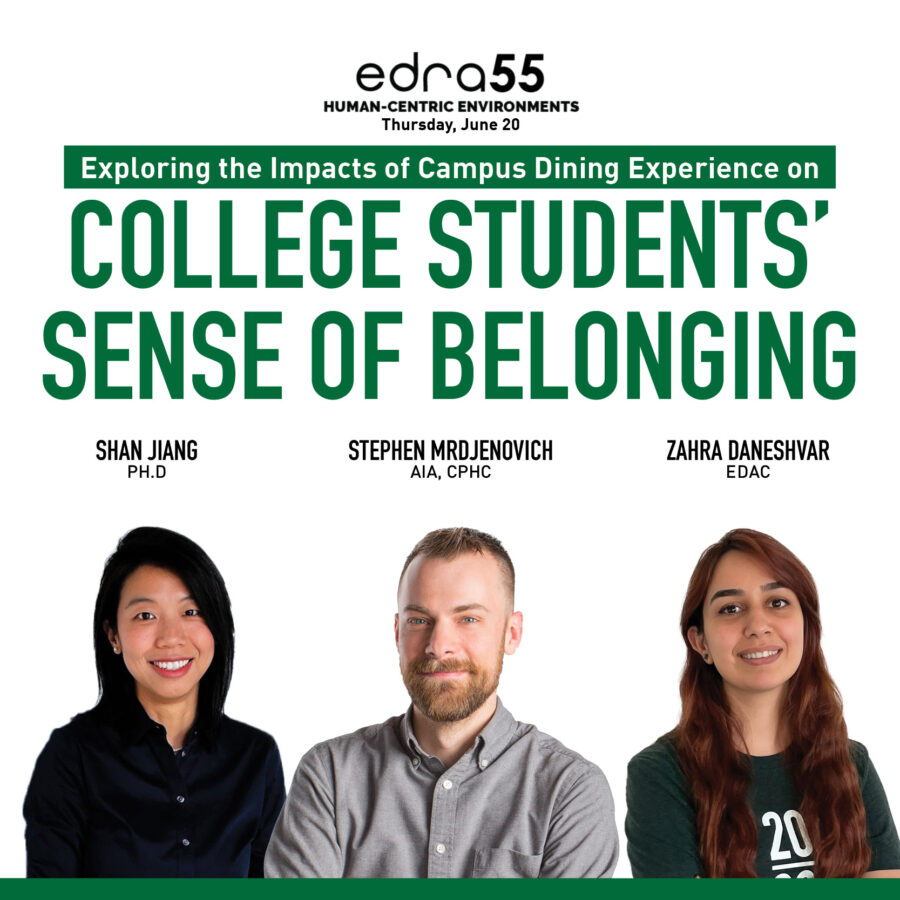Insights
Nov 13, 2024 _ insights
Nourishing Belonging
At the Environmental Design Research Association (EDRA) annual conference, we shared preliminary insights from a pre-occupancy evaluation of an existing campus dining facility, titled, Nourishing Belonging: Exploring the Campus Dining Experience on College Students’ Sense of Belonging. The data collected from this evaluation is informing the renovation we’ll be doing at this facility, located on a Pennsylvania campus. We’ll be sharing final data once our renovation and post-occupancy study are complete.
We know from existing research that student persistence and success are driven by their sense of engagement and belonging. For this pre-occupancy evaluation we started by asking, “what role might the sense of belonging play in food court spaces on a college campus”?
To begin to answer this question, we designed our research to include a literature review of 55 peer-reviewed publications, which helped us develop a survey questionnaire for current students of the university. Our research also included findings from existing studies to provide a theoretical foundation, user-experience studies, and occupancy evaluations.
Preliminary findings indicate that housing status (living on campus v. commuting) and year of student (first, second, third, or fourth year in college) can impact students’ perception of dining hall design. Students who have resided on campus for three years or longer tend to rate the aesthetics of the current food court lower. We also found that the frequency of student visits to the food court is driven largely by their purpose (mealtimes v. socializing, relaxing, or learning). Student use of the food facility for socializing was impacted by acoustics, with too much noise negatively impacting opportunities for social engagement. For students looking to study or work on group projects in the current space, insufficient lighting negatively impacted their ability to use this space for learning.
We’ve found that research on how students use space in the existing conditions and their expectations for the quality (like lighting and acoustics) can significantly impact the design solutions of renovation projects like this. Well-designed research studies gather crucial information that helps ensure renovations create the desired impact. Understanding student perceptions and use habits help designers address their needs while wisely using university design dollars.
See our presentation here.
Read more of our student dining insights here.
Learn more about research at GBBN here.
See more of our higher education work here.
 Shan Jiang, Ph.D, is an associate and the director of research at GBBN. An established researcher, educator, and thought leader, she has published dozens of articles in peer-reviewed journals, presented at conferences, and recently published a full monograph with Routledge on therapeutic landscapes, healthcare design, and sustainable community development. At GBBN, Shan leads firm-wide research efforts, helping design teams in all markets conduct research while drawing on the best, established research to inform their work.
Shan Jiang, Ph.D, is an associate and the director of research at GBBN. An established researcher, educator, and thought leader, she has published dozens of articles in peer-reviewed journals, presented at conferences, and recently published a full monograph with Routledge on therapeutic landscapes, healthcare design, and sustainable community development. At GBBN, Shan leads firm-wide research efforts, helping design teams in all markets conduct research while drawing on the best, established research to inform their work.
 Stephen Mrdjenovich, AIA, CPHC is an associate principal at GBBN. A leader within GBBN’s Sustainability Action Network, Stephen is helping shift GBBN’s design process to ensure that ambitious sustainability, resilience, and well-being goals shape all our work. Working within the firm’s community development, higher education, and arts markets, Stephen’s passion for sustainable design and his understanding of how to bring that commitment to life have shaped a wide variety of projects, including Federal House at Penn State Behrend.
Stephen Mrdjenovich, AIA, CPHC is an associate principal at GBBN. A leader within GBBN’s Sustainability Action Network, Stephen is helping shift GBBN’s design process to ensure that ambitious sustainability, resilience, and well-being goals shape all our work. Working within the firm’s community development, higher education, and arts markets, Stephen’s passion for sustainable design and his understanding of how to bring that commitment to life have shaped a wide variety of projects, including Federal House at Penn State Behrend.
 Zahra Daneshvar, EDAC is an interior designer and researcher at GBBN. Zahra combines her passions for interior design and research to create uplifting environments that positively impact human health and well-being. She likes to incorporate new technologies, like video mapping, in her design process to help create immersive experiences. Her higher education interior design work includes projects at Penn State University and Carnegie Mellon University.
Zahra Daneshvar, EDAC is an interior designer and researcher at GBBN. Zahra combines her passions for interior design and research to create uplifting environments that positively impact human health and well-being. She likes to incorporate new technologies, like video mapping, in her design process to help create immersive experiences. Her higher education interior design work includes projects at Penn State University and Carnegie Mellon University.




